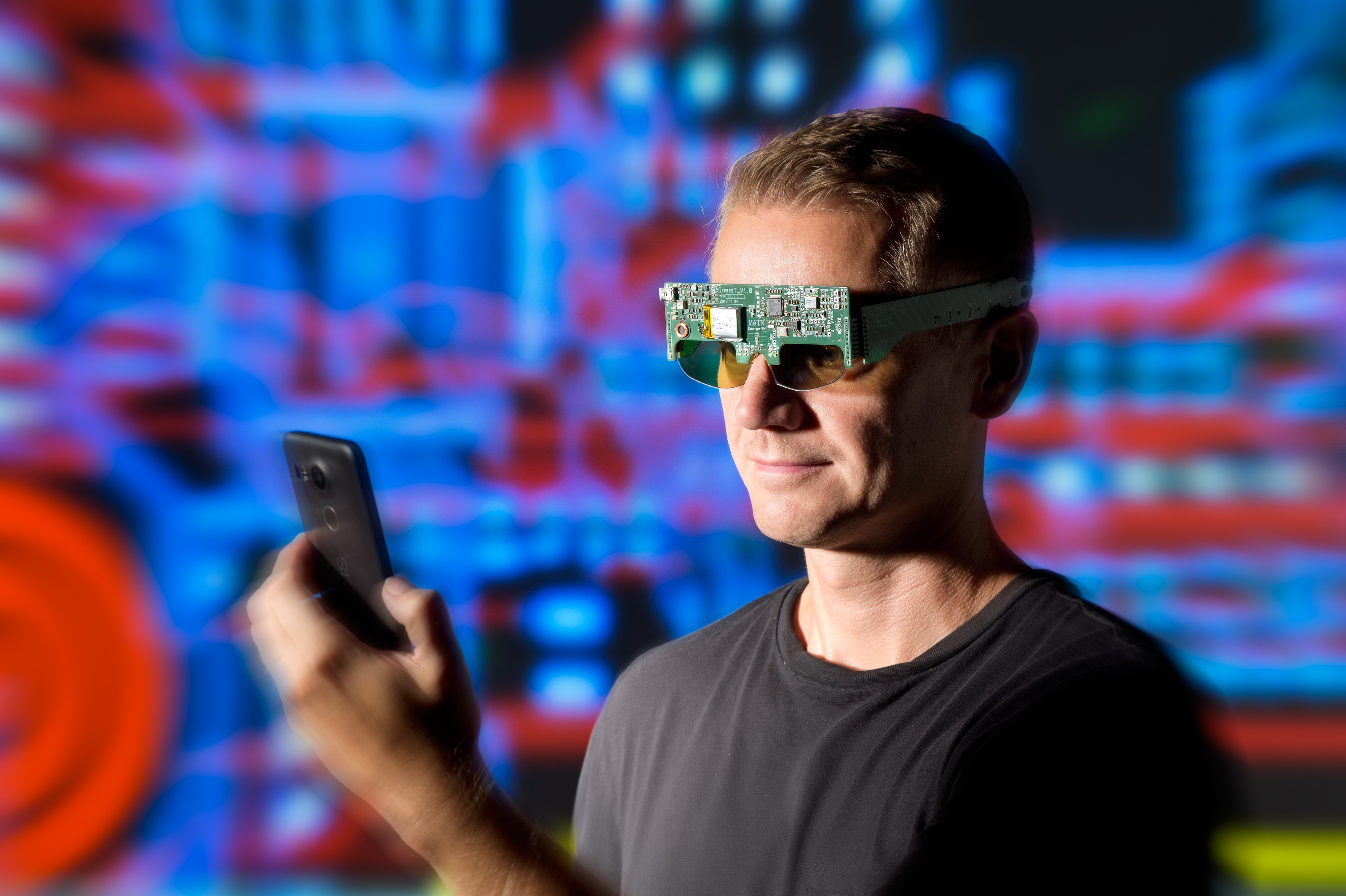Fraunhofer IBMT at MEDICA 2018: Treating amblyopia in children
Interactive shutter eyeglasses to replace eyepatch therapy
The standard treatment for so-called lazy eye (amblyopia) in children is to cover the nonimpaired eye with a patch. This trains the impaired eye to work harder. Such therapy is successful only when the patient wears the eyepatch for the prescribed period of time. This is often not the case, however, as many children feel self-conscious about wearing the patch and reject this form of treatment. A future alternative is electronic shutter eyeglasses that automatically darken the lens in front of the nonimpaired eye when the context is appropriate. These eyeglasses also have integrated sensors that provide young wearers with feedback on whether they are being worn in the correct position. Fraunhofer researchers will be exhibiting a functional model of the electronic shutter eyeglasses at the MEDICA trade fair in Düsseldorf from November 12 to 15 (Hall 10, Booth G05/H04).

Lazy eye is a common complaint among children. The standard treatment for this visual impairment – amblyopia, as ophthalmologists call it – is to cover up the good eye with a patch. This trains the lazy eye to work harder – and the brain to receive its signals. The sooner treatment begins, the greater the chances of recovery. However, there are two main drawbacks to this form of occlusion therapy: vision is spatially restricted, and children often experience the eyepatch as unsightly and therefore refuse to wear it. Moreover, such treatment is successful only when the eyepatch is worn for the prescribed period of time. In a collaborative project (see "InsisT – project overview”), research and industry are aiming to achieve a decisive improvement in this often difficult therapy for young children. They hope that new interactive, context-dependent shutter eyeglasses with sensor-based feedback will increase treatment compliance for this complaint. This new technology covers up the patient’s good eye only when the situation is appropriate. During sport, for example, or other activities that demand good spatial vision, this function is deactivated so as to avoid any risk of accident.
Multimodal sensor system integrated in temples
Use and operation of the shutter eyeglasses are controlled by a multimodal sensor system integrated in the temples of the eyeglasses. Researchers at Fraunhofer Institute for Biomedical Engineering IBMT have developed this new technology along with a smartphone app to enable parents to monitor the treatment. All the data generated by this technology is compiled in a digital patient file system, which was also developed by the IBMT team. This web-based application is compliant with data-protection laws and can be accessed by the ophthalmologist in order to monitor, adjust and enhance treatment. For example, it tells the doctor if and when the patient has worn the eyeglasses – information that was never available with conventional treatment. “The data is uploaded to the app via Bluetooth and then securely archived in a cloud database,” explains Dr. Frank Ihmig, a scientist at Fraunhofer IBMT in St. Ingbert. “Our goal is to provide an individual, patient-based therapy.”
Boosting therapy acceptance
Data for real-time processing is generated by various sensors. These include temperature and skin-contact sensors to monitor the length of time and the position in which the eyeglasses have been worn. They also measure the occlusion phases, during which the LCD lenses are darkened. “This data is logged in an electronic memory device integrated in the eyeglass frames,” Ihmig explains. The eyeglass lenses are darkened by means of an electronically controlled shuttering system based on integrated liquid crystals. The frequency and duration of the occlusion therapy can be individually adjusted to each specific case. It is therefore more versatile than conventional eyepatch treatment. In this way, project partners hope to encourage young patients to wear the eyeglasses for the prescribed duration. The skin-contact sensors monitor whether the eyeglasses are being worn in the correct position and even provide the young wearer with child-friendly feedback. This can help increase acceptance for this form of therapy, too.
An acceleration sensor recognizes specific patterns of movement and can distinguish between different activities such as standing up, lying down, sitting down, walking, running, jumping, cycling and climbing stairs. “Our shutter eyeglasses are contextsensitive,” Ihmig explains. “This means that when the wearer is involved in energetic activities such as sport, for example, the mechanism for darkening the LCD lenses is deactivated, and they remain clear. This ensures full spatial vision and removes the risk of the wearer being involved in an accident.”
Initial tests with amblyopic children are scheduled for the second quarter of 2019. In addition, it is hoped that a validation study to be conducted toward the end of the project will confirm the medical benefits of the therapy.
Researchers have already developed a first functional model of the electronics for the new eyeglasses. The next step will be to make these smaller so they can be integrated in children’s eyeglass frames. In parallel, they are working to make the electronics more energy-efficient and thereby prolong battery life. The battery is recharged inductively, i.e., without a cable.
The functional model will be on display at the joint Fraunhofer booth (Hall 10, Booth G05/H04) at the MEDICA trade fair in Düsseldorf from November 12 to 15.
InsisT – project overview
Project duration: 2017 to 2020
Project funded by: German Federal Ministry of Education and Research (BMBF)
Project partners
• Augenklinik Sulzbach
• BEO MedConsulting Berlin GmbH
• Fraunhofer Institute for Biomedical Engineering IBMT, St. Ingbert
• Novidion GmbH, Cologne (Coordinator)